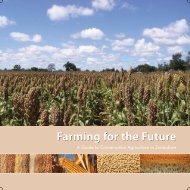Restoring the Soil - Canadian Foodgrains Bank
Restoring the Soil - Canadian Foodgrains Bank
Restoring the Soil - Canadian Foodgrains Bank
Create successful ePaper yourself
Turn your PDF publications into a flip-book with our unique Google optimized e-Paper software.
50Decision Tree Guideeties should not be intercropped with sorghum or millet, because <strong>the</strong> sorghumand millet stalks will not support <strong>the</strong> weight of <strong>the</strong> intercropped beans.Vigna species fix much more nitrogen than do <strong>the</strong> common beans (Phaseolusvulgaris). They can fix approximately 80 kg N/ha as opposed to about 30 kg N/ha for Phaseolus beans, so just switching from Phaseolus beans to a Vigna speciesas an intercrop can make a major difference in <strong>the</strong> maintenance of soil fertility(assuming all <strong>the</strong> nitrogen is not being burned off during <strong>the</strong> dry season).In general, among <strong>the</strong> Vignas, cowpeas and rice beans are more drought-resistant,while mungbeans require more soil moisture. For <strong>the</strong> driest situations, especiallyat <strong>the</strong> end of <strong>the</strong> wet season when soil moisture can be expected to graduallydecrease, short-cycle (60- to 70-day) cowpeas are probably <strong>the</strong> best option.In places like <strong>the</strong> Sahel, <strong>the</strong> introduction of short-cycle cowpeas can improvesoil fertility, because <strong>the</strong> crops with which <strong>the</strong>y are intercropped usually last atleast a month longer. This fact means that <strong>the</strong> cowpea residues—at least thatpart of <strong>the</strong>m that is not carried off to sell or store for forage—will die and beincorporated into <strong>the</strong> soil by termites before <strong>the</strong> millet or sorghum is harvested.In this way, <strong>the</strong> organic matter is protected from <strong>the</strong> heat and from o<strong>the</strong>r farmers’grazing animals, which are not allowed to roam free until <strong>the</strong> millet or sorghumis harvested.If you are working with cowpeas, select S22, S68, S70, S73, S74 or S80, and <strong>the</strong>ngo to #5. If you are working with rice beans, select S9, S69 or S78 and <strong>the</strong>n go to#5. If working with mungbeans, select S79 or S85, and <strong>the</strong>n go to #5. Hedgerowscan also be used with <strong>the</strong>se systems, and are advisable especially under 800m in elevation. See #45.39. Pigeon peas. Pigeon peas can be used as a gm/cc in many different ways.a) Pigeon peas can be a very good temporary, dispersed shade (up to four years)for vegetables or o<strong>the</strong>r low-stature crops. They allow flexibility in complicatedand changing farming systems because <strong>the</strong>y can be taken out or replanted at anytime. They also provide a high-protein food and fertilize <strong>the</strong> soil very well. See#26.b) Pigeon peas can be used as an improved fallow. See #26.c) If you want to try a system in which pigeon peas are intercropped with maize,go to S30 and <strong>the</strong>n go to #5. For upland rice, go to S72 and <strong>the</strong>n #5. Pigeon peascan also be grown toge<strong>the</strong>r with many o<strong>the</strong>r crops, often benefiting <strong>the</strong>m becauseof <strong>the</strong> shade while producing additional food and organic matter for <strong>the</strong> soil.40. Peanuts and bambara groundnuts. Peanuts and bambara groundnuts are oftenplanted toge<strong>the</strong>r with maize, sorghum, millet and even cassava. They are usuallyplanted at <strong>the</strong> same time as <strong>the</strong> basic grains with which <strong>the</strong>y are being intercropped.Both species can also be intercropped with cassava (see S43, and <strong>the</strong>n#5, if you and <strong>the</strong> farmers wish).I did not describe <strong>the</strong>se systems below. They do not fertilize <strong>the</strong> soil well because
















